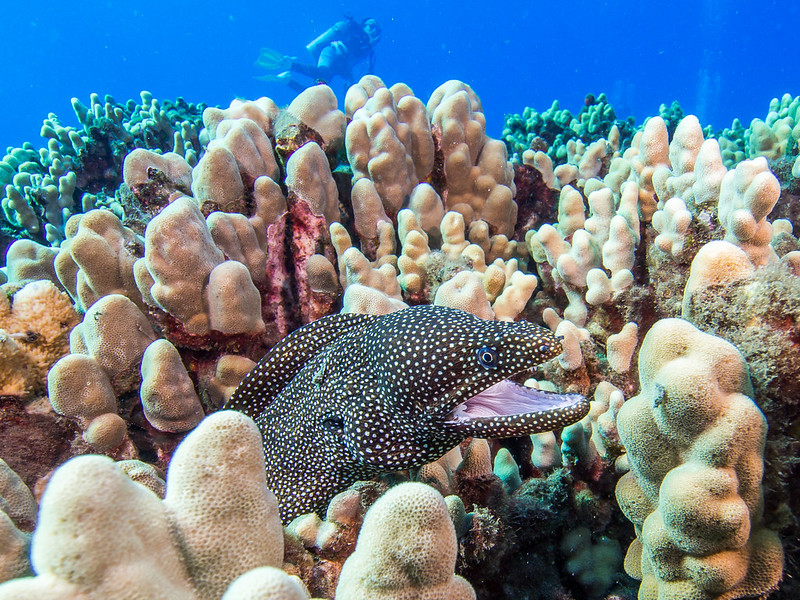According to researchers at the University of Hawaii, a newly discovered seaweed has been wreaking havoc on the pristine coral reefs throughout the Northern Hawaiian islands. Individual mats of this seaweed are as big as football fields, have the ability to break off and form tumbleweed-like structures, and- most dangerously- compete with corals for nutrients and light. They have described this seaweed as ‘highly destructive with the potential to outgrow entire reef systems’.
—
The seaweed was discovered in the Papahanaumokuakea Marine National Monument, a pristine conservation area with high ecological value considered as a World Heritage Site. The area is home to over 7 000 marine species, 14 million seabirds, and is home to the threatened green sea turtle and endangered Hawaiian monk seal. Each of these species relies on the existing reef systems for shelter, food and structural protection (erosion protection from waves).
The red seaweed, known as Chondria tumulosa, was initially discovered through surveys conducted by the National Oceanic and Atmospheric Administration (NOAA) back in 2016. The first appearance was in the Pearl and Hermes Atoll. A follow-up survey was conducted in 2019 and it was then that researchers discovered their alarming growth rates that had covered entire reef systems. From DNA testing, there is no existing match of known algae, hence it is considered a new type of seaweed in the genus Chondria.
According to the US National Invasive Species Information Center, the new seaweed is not considered invasive, as it is unknown whether it was introduced to the native islands by humans or if it originated from there in very small numbers and only recently exploded. Normally, marine invasive species are introduced into new areas via human activities, through fish being accidentally transported on ships, for example.
Researchers have instead characterised the seaweed as a ‘nuisance species’ due to the sudden ecological impact caused by its expansive and explosive growth. There is conclusive evidence of their abilities to destroy coral reefs; according to the published article, the seaweed was found to outgrow native reef species and replace keystone species, fundamentally, changing the ecological structure of reefs. This has caused irreversible damage to coral reefs in Hawaii because the seaweed is outcompeting the corals for light and nutrients, causing a collapse in the ecosystem.
You might also like: 481 and Counting: Norway’s Whaling Catch Hits Four-Year High
The researchers are also concerned at the seaweed’s tendency to break off into tumbleweed-like structures and travel far distances, posing risks for nearby coral reef ecosystems.
Another example where an invasive species has decimated the native ecosystem is that of the lionfish. Originating from the South Pacific and Indian Ocean, the lionfish has invaded the Atlantic ocean, with frequent sightings along the southeastern coast of the US and the Bermuda Islands. The Lionfish hunts and outcompetes native fish for food, causing an imbalanced food chain.
In areas where the seaweed had taken over, Heather Spalding, one of the researchers and an algae specialist from the University of Hawaii says that “everything was dead underneath.” The large mats of seaweed essentially block light that corals need to live, making it difficult for these and other marine life to flourish. Known species of fish that graze on algae do not touch the new seaweed, and such areas are void of marine life.
Determining the causes of a systemic change in the ecosystem is rather difficult but one important factor favouring seaweed growth is increasing ocean temperatures. Opportunistic seaweed can adapt to fluctuating warmer waters and completely overtake coral-dominated systems. An example of this is in the Gulf of Maine where there used to be an abundance of kelp beds but these are currently being overtaken by turf seaweed. Growth of kelp beds favour lower temperatures and they provide large areas of cover for the native fish. Without this cover, native fish are being predated on by migratory fish species.
Seasonal changes can contribute to seaweed blooms throughout the year, but with over 20 years of NOAA observations and surveys in the area, the researchers have concluded that it is not an ordinary seaweed seasonal growth, but rather a symptom of an existing problem, such as increasing water temperature from climate change.
To combat this nuisance seaweed and save coral reefs in Hawaii and beyond, it is vital to find out the origins and causes of growth, both of which are still unknown at this stage. The researchers are returning to the area to study for more information.
Featured image by: Mike Cialowicz


















